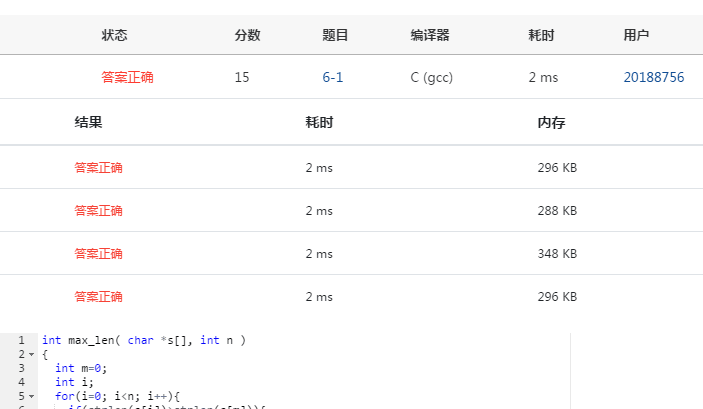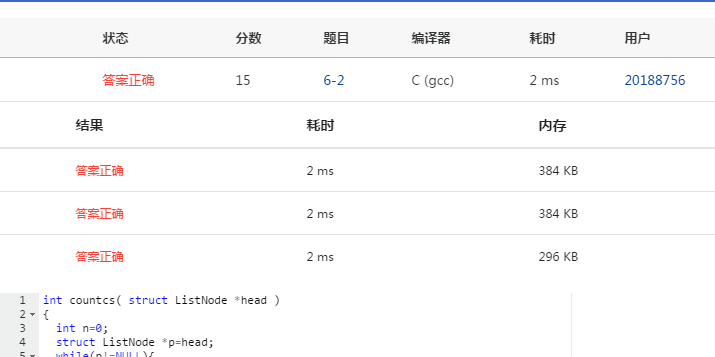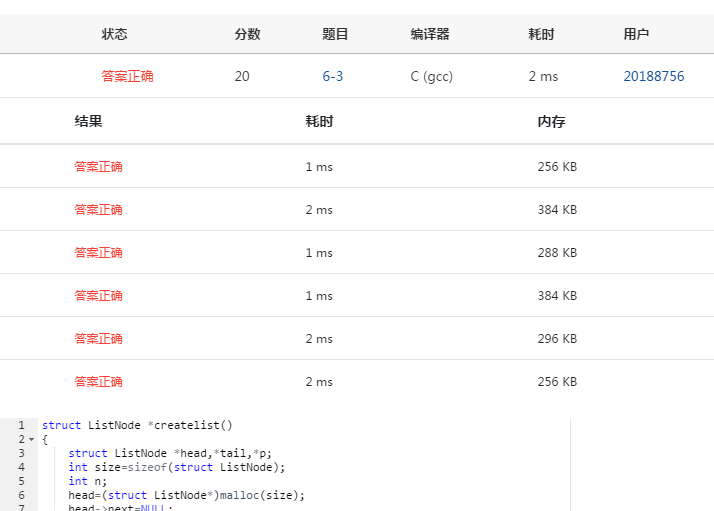2019第十二周作业
2019年春季学期第十二周作业
| 课程名称 | c语言程序设计2 |
|---|---|
| 作业要求 | 第十二周作业 |
| 我的课程目标 | 了解指针与函数的关系,掌握指针作为函数返回值 |
| 这个作业在哪个方面帮助我实现目标 | 了解了指针与函数的关系及指针与函数的关系 |
| 参考文献 | 课本c语言程序设计 |
基础作业一
6-1 计算最长的字符串长度 (15 分)
本题要求实现一个函数,用于计算有n个元素的指针数组s中最长的字符串的长度。
函数接口定义:
int max_len( char *s[], int n );
其中n个字符串存储在s[]中,函数max_len应返回其中最长字符串的长度。
裁判测试程序样例:
#include <stdio.h>
#include <string.h>
#include <stdlib.h>
#define MAXN 10
#define MAXS 20
int max_len( char *s[], int n );
int main()
{
int i, n;
char *string[MAXN] = {NULL};
scanf("%d", &n);
for(i = 0; i < n; i++) {
string[i] = (char *)malloc(sizeof(char)*MAXS);
scanf("%s", string[i]);
}
printf("%d
", max_len(string, n));
return 0;
}
/* 你的代码将被嵌在这里 */
输入样例:
4
blue
yellow
red
green
输出样例:
6
(1)实验代码
Int max_len( char *s[], int n )
{
int w=0;
int i;
for(i=0;i<n;i++){
if(strlen(s[i])>strlen(s[w])){
w=i;
}
}
return strlen(s[w]);
}
(2)设计思路
流程图
(3)实验遇到的问题及解决方案
无
(4)运行结果截图

基础作业二
6-2 统计专业人数 (15 分)
本题要求实现一个函数,统计学生学号链表中专业为计算机的学生人数。链表结点定义如下:
struct ListNode {
char code[8];
struct ListNode *next;
};
这里学生的学号共7位数字,其中第2、3位是专业编号。计算机专业的编号为02。
函数接口定义:
int countcs( struct ListNode *head );
其中head是用户传入的学生学号链表的头指针;函数countcs统计并返回head链表中专业为计算机的学生人数。
裁判测试程序样例:
#include <stdio.h>
#include <stdlib.h>
#include <string.h>
struct ListNode {
char code[8];
struct ListNode *next;
};
struct ListNode *createlist(); /*裁判实现,细节不表*/
int countcs( struct ListNode *head );
int main()
{
struct ListNode *head;
head = createlist();
printf("%d
", countcs(head));
return 0;
}
/* 你的代码将被嵌在这里 */
输入样例:
1021202
2022310
8102134
1030912
3110203
4021205
#
输出样例:
3
(1)实验代码
int countcs( struct ListNode *head )
{
int n=0;
struct ListNode *p=head;
while(p!=NULL){
if(p->code[1]=='0'&&p->code[2]=='2'){
n++;
}
p=p->next;
}
return n;
}
(2)设计思路
流程图
(3)实验遇到的问题及解决方案
(4)运行结果截图

基础作业三
6-3 删除单链表偶数节点 (20 分)
本题要求实现两个函数,分别将读入的数据存储为单链表、将链表中偶数值的结点删除。链表结点定义如下:
struct ListNode {
int data;
struct ListNode *next;
};
函数接口定义:
struct ListNode *createlist();
struct ListNode *deleteeven( struct ListNode *head );
函数createlist从标准输入读入一系列正整数,按照读入顺序建立单链表。当读到−1时表示输入结束,函数应返回指向单链表头结点的指针。
函数deleteeven将单链表head中偶数值的结点删除,返回结果链表的头指针。
裁判测试程序样例:
#include <stdio.h>
#include <stdlib.h>
struct ListNode {
int data;
struct ListNode *next;
};
struct ListNode *createlist();
struct ListNode *deleteeven( struct ListNode *head );
void printlist( struct ListNode *head )
{
struct ListNode *p = head;
while (p) {
printf("%d ", p->data);
p = p->next;
}
printf("
");
}
int main()
{
struct ListNode *head;
head = createlist();
head = deleteeven(head);
printlist(head);
return 0;
}
/* 你的代码将被嵌在这里 */
输入样例:
1 2 2 3 4 5 6 7 -1
输出样例:
1 3 5 7
(1)实验代码
struct ListNode *createlist()
{
struct ListNode *head,*tail,*p;
int size=sizeof(struct ListNode);
int n;
head=(struct ListNode*)malloc(size);
head->next=NULL;
tail=head;
while(p!=NULL)
{
p=(struct ListNode*)malloc(size);
p->next=NULL;
scanf("%d",&n);
if(n==-1)
break;
p->data=n;
p->next=NULL;
tail->next=p;
tail=p;
}
return head;
}
struct ListNode *deleteeven( struct ListNode *head )
{
struct ListNode *pr1,*pr2;
int f;
pr1=head;
pr2=pr1->next;
while(pr1->next)
{
f=0;
if(pr2->data%2==0)
{
pr1->next=pr2->next;
pr2=pr2->next;
f=1;
}
if(f==0)
{
pr1=pr1->next;
pr2=pr1->next;
}
}
return head->next;
}
(2)设计思路
流程图
(3)实验遇到的问题及解决方案
(4)运行结果截图

挑战作业
7-3 ***八皇后问题 (20 分)
在国际象棋中,皇后是最厉害的棋子,可以横走、直走,还可以斜走。棋手马克斯·贝瑟尔 1848 年提出著名的八皇后问题:即在 8 × 8 的棋盘上摆放八个皇后,使其不能互相攻击 —— 即任意两个皇后都不能处于同一行、同一列或同一条斜线上。
现在我们把棋盘扩展到 n × n 的棋盘上摆放 n 个皇后,请问该怎么摆?请编写程序,输入正整数 n,输出全部摆法(棋盘格子空白处显示句点“.”,皇后处显示字母“Q”,每两格之间空一格)。
输入格式
正整数 n (0 < n ≤ 12)
输出格式
若问题有解,则输出全部摆法(两种摆法之间空一行),否则输出 None。
要求:试探的顺序逐行从左往右的顺序进行,请参看输出样例2。
输入样例1
3
输出样例1
None
输入样例2
6
输出样例2
. Q . . . .
. . . Q . .
. . . . . Q
Q . . . . .
. . Q . . .
. . . . Q .
. . Q . . .
. . . . . Q
. Q . . . .
. . . . Q .
Q . . . . .
. . . Q . .
. . . Q . .
Q . . . . .
. . . . Q .
. Q . . . .
. . . . . Q
. . Q . . .
. . . . Q .
. . Q . . .
Q . . . . .
. . . . . Q
. . . Q . .
. Q . . . .
我的参考文献
7-2 求迷宫最短通道 (20 分)
递归求解迷宫最短通道的总步长。输入一个迷宫,求从入口通向出口的可行路径中最短的路径长度。为简化问题,迷宫用二维数组 int maze[10][10]来存储障碍物的分布,假设迷宫的横向和纵向尺寸的大小是一样的,并由程序运行读入, 若读入迷宫大小的值是n(3<n<=10),则该迷宫横向或纵向尺寸都是n,规定迷宫最外面的一圈是障碍物,迷宫的入口是maze[1][1],出口是maze[n-2][n-2], 若maze[i][j] = 1代表该位置是障碍物,若maze[i][j] = 0代表该位置是可以行走的空位(0<=i<=n-1, 0<=j<=n-1)。求从入口maze[1][1]到出口maze[n-2][n-2]可以走通的路径上经历的最短的总步长。要求迷宫中只允许在水平或上下四个方向的空位上行走,走过的位置不能重复走。
输入格式:
输入迷宫大小的整数n, 以及n行和n列的二维数组(数组元素1代表障碍物,0代表空位)
输出格式:
若有可行的通道则输出一个整数,代表求出的通道的最短步长;若没有通道则输出"No solution"
输入样例:
10
1 1 1 1 1 1 1 1 1 1
1 0 0 1 0 0 0 1 0 1
1 0 0 1 0 0 0 1 0 1
1 0 0 0 0 1 1 0 0 1
1 0 1 1 1 0 0 0 0 1
1 0 0 0 1 0 0 0 0 1
1 0 1 0 0 0 1 0 0 1
1 0 1 1 1 0 1 1 0 1
1 1 0 0 0 0 0 0 0 1
1 1 1 1 1 1 1 1 1 1
上述输入代表的是如下这样一个迷宫:

其中红色的小方块是障碍物,蓝色的小方块是空位,白色的小圆连起来是一条从入口到出口的通道,两个圆之间代表一个步长。
输出样例:
14
我的参考文献
预习作业
1.项目名称:飞机大战。目标:发射激光。
2项目主体功能:飞机能发射子弹并且击中目标,游戏能判断胜负,而且能判断音效。
3线阶段准备工作:对飞机控制的预习。
4成员:龙佳思,王俊杰,黄松
学习感悟
结对编程感想